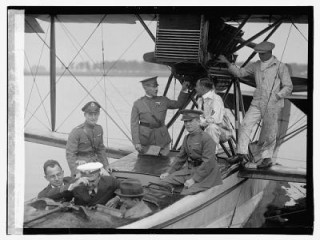
Mason M. Patrick biography
Date of birth : 1863-12-13
Date of death : 1942-01-29
Birthplace : Lewisburg, West Virginia, U.S.
Nationality : American
Category : Arhitecture and Engineering
Last modified : 2011-06-16
Credited as : Army engineer and pilot, head of American aviation,
0 votes so far
Mason M. Patrick was the first real head of American aviation. Although an Army engineer for 30 years, in 1918 Gen John J. Pershing, Patrick's West Point classmate, appointed him as commander of the Air Service in France. In Pershing's words, there were many fine people in the air arm, but they were "running around in circles"; he wanted Patrick to make them go straight. Although knowing virtually nothing about aviation at that point, Patrick was an excellent organizer and administrator. By the end of the war, the Air Service was an efficient and wellrun combat arm. After the armistice Patrick returned to the Corps of Engineers, but in late 1921 he was recalled to the Air Service. His predecessor, Charles Menoher, could not get along with the most famous airman of the day, William ("Billy") Mitchell, and, in the resulting power struggle, Menoher lost. Because Patrick had managed the difficult airman during the war, he was given the opportunity to do so again. For the next six years Patrick remained at the helm, although Mitchell left the service in 1926. Patrick's memoir, The United States in the Air (Garden City, N.Y.: Doubleday, Doran, and Co., 1928) is, as the title implies, a rather sweeping look at the function and organization of airpower in this country, rather than a strictly autobiographical work. It is disappointing. The style is leaden, and we are provided very few insights into the personalities and issues so turbulent at the time. Except for the oftrepeated story of how Patrick-upon his assumption of command in October 1921-confronted Mitchell, and won, the controversial airman is barely mentioned. Similarly, the key issues of air strategy during and after the war, the organization of the new air arm and its role in national defense, and its relationships with the Navy are extremely muted. In short, although Patrick was a key player at a most important time in American airpower history, this book sheds little light on anything of importance during that era.
Patrick's only biographer to date is Bruce A. Bingle, who wrote "Building the Foundation: Major General Mason Patrick and the Army Air Arm, 1921-1927," MA thesis, Ohio State, 1981. Bingle does a workmanlike job of presenting a bureaucratic history of the Air Service as seen through the eyes of Patrick. It is a fairly sympathetic account, and portrays the air chief as an airpower advocate as determined as Billy Mitchell, but possessing far more tact and political acumen. Missing, however, is a more personal insight into Patrick's personality and leadership style.
In addition, Patrick is currently being examined by Maj Robert White, a historian on the Air Staff at the Pentagon. His study, a dissertation for Ohio State University, will focus on Patrick's tenure as head of the Air Service and then the Air Corps. White hopes to complete his biography by the summer of 1995.
















